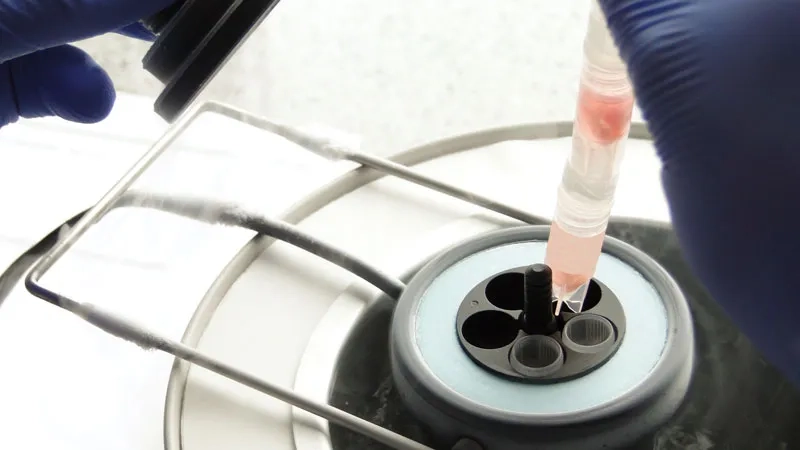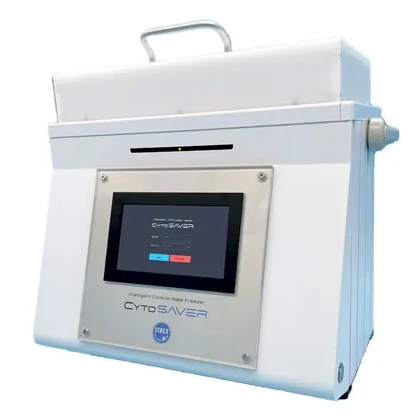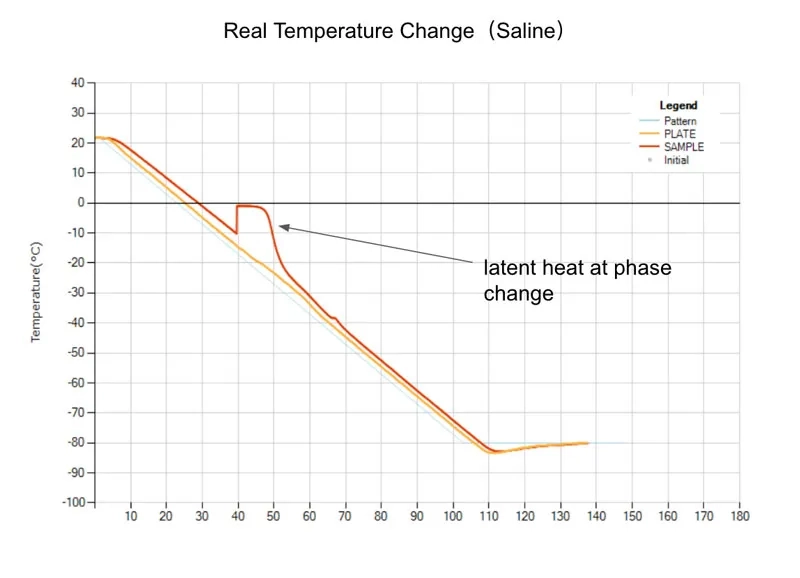Nitrogen-Free Controlled-Rate Freezers: The Solution for Cell Preservation Challenges
The CytoSAVER offers precise monitoring and control for the most sensitive controlled-rate freezing applications
Freezing and cryopreservation have become vital processes in the lab. Freezing specimens, samples, and reagents allows them to be stored for extended periods of time without the risk of degradation. Cryopreservation serves a critical function in ensuring the protection of sensitive samples for discovery research and cell therapeutic development.
The key to any cryopreservation protocol is ensuring variations in freezing conditions are kept to a minimum. This can be a challenge, however, without the right tools and equipment to monitor and control the freezing process.
A solution such as the CytoSAVER nitrogen-free controlled-rate freezer can take risk and variation out of the cryopreservation equation. Such peace of mind allows researchers to focus on the science rather than worry about the viability and safety of their precious samples.
Considerations of the cryopreservation process
 Today’s
labs place increased demands on cold storage of biological samples. This is
especially true for researchers in cell biology, regenerative medicine, and
biobanking operations. Stem cells in particular require special handling to
preserve their use in clinical and research applications. Such demands may extend
to safety and quality control testing for cell therapeutic manufacturing as
well. For these challenging and important applications, the enactment of strict
cryopreservation protocols is crucial in preventing physical damage to cell
samples and ensuring their vitality for future work.
Today’s
labs place increased demands on cold storage of biological samples. This is
especially true for researchers in cell biology, regenerative medicine, and
biobanking operations. Stem cells in particular require special handling to
preserve their use in clinical and research applications. Such demands may extend
to safety and quality control testing for cell therapeutic manufacturing as
well. For these challenging and important applications, the enactment of strict
cryopreservation protocols is crucial in preventing physical damage to cell
samples and ensuring their vitality for future work.
The main objective of any cryopreservation protocol is to minimize or eliminate the formation of ice crystals during the temperature lowering process. Such ice formation can damage cells during storage and affect viability upon subsequent thawing. To confront this issue, cryogenic agents such as dimethyl sulfoxide (DMSO) and controlled-rate freezers are used to stabilize and lower the temperature of cell samples under tightly controlled conditions.
Differences between controlled-rate and mechanical freezers
Most standard ultra-low temperature (ULT) freezers employ cascade technology. One compressor lowers the temperature to an intermediate point, at which time the second compressor kicks in, lowering the temperature to the target set point. Depending on temperature demands, the low temperature compressor can cycle on and off to maintain the temperature within a set degree range.
Some ULT freezers employ engine-driven technology, which can lower the temperature without the need for two compressors working in stages. Depending on the system, the temperature lowering profile can be more consistent overall compared with standard ULT freezers.
Controlled-rate freezers focus on maintaining the low temperature set point like ULT freezers. Most importantly, though, they actively monitor and tightly control the rate of the temperature lowering process to ensure conditions of the preservation protocol are achieved. High-precision temperature control helps ensure samples are well-behaved during the freezing process and their viability is stable upon subsequent thawing and use.
Challenges of controlled-rate freezing
There are two main types of controlled-rate freezers—those that employ liquid nitrogen and those that function liquid nitrogen-free.
Procuring and storing liquid nitrogen can be costly. It can be a maintenance burden on the lab as well. Liquid nitrogen freezers require monitoring of the temperature and nitrogen levels. They also can require frequent cleaning to remove potential contaminants.
The use of liquid nitrogen-free controlled-rate freezers, on the other hand, can help avoid costs, reduce maintenance requirements, and offer versatility and portability. These freezers typically have a smaller footprint and operate free of potential contaminants—such as mycoplasma—compared to liquid nitrogen freezers, meaning they can be deployed in clean rooms and areas where space is a premium.
Not all cell preparations share the same handling requirements. Additives such as DMSO and the use of liquid nitrogen can be effective for cell preservation. However, these factors can introduce potential contamination into the cell samples if not properly controlled.
Liquid nitrogen-free controlled-rate freezers can be adjusted to match the needs of a wide variety of cell types and sample preservation requirements. The freezers can eliminate the burden of liquid nitrogen while accommodating the use of cryoprotective agents such as DMSO.
Although there are many advantages, there are some considerations for the use of liquid nitrogen-free controlled-rates freezers that should be mentioned. For instance, some controlled-rate freezers have a limited capacity for samples compared to their liquid nitrogen counterparts. Limited options for freezing conditions can be another issue. For instance, vitrification or snap freezing can be preferred for certain tissues and sensitive samples, such as single-cell preparations. This type of instantaneous freezing can present a challenge for some liquid nitrogen-free controlled-rate freezers. Despite this, most cells prefer freezing velocities closer to the physical limit of -1 °C per minute, and having the ability to adjust this freezing rate provides a more versatile solution to protect and preserve a broader range of sample types.
The CytoSAVER as a solution to cell preservation challenges
 The
ideal liquid nitrogen-free controlled-rate freezer should combine the power of precise
temperature control with intuitive features and user access.
The
ideal liquid nitrogen-free controlled-rate freezer should combine the power of precise
temperature control with intuitive features and user access.
The CytoSAVER liquid nitrogen-free controlled-rate freezer accomplishes this with the following features:
- A user-friendly interface accessible with a built-in touchscreen
- The ability to program your desired freezing pattern—in accordance with your cryopreservation protocol—with the option to generate PDF reports
- A sterile interior, making it ideal for cleanrooms and liquid nitrogen-free isolators
- A lightweight and compact design
- Built-in heating to ensure frozen sample plates return to room temperature in proper time
The CytoSAVER has a flexible and robust design:
- The compact and efficient design has a capacity of 81 screw-top cryogenic tubes (0.5-2.0 mL) for models FZ-2100 and FZ-2200, and 171 tubes for models FZ-3100 and FZ-3200
- Sample capacity can be expanded if necessary
- The freezing rate can be programmed to a lower limit of -0.1 °C/min and a max rate of -10 °C/min (The actual temperature changes may differ from the set rates)
- Since the CytoSAVER can easily hold temperature at -80 °C, vitrification or snap freezing can easily be accomplished
In addition, the CytoSAVER offers the ability to track the progress of your cryopreservation process using a comprehensive freezing process graphing function (example shown below). The system provides real-time updates and records sample temperature changes, delivering greater confidence and control.

CytoSAVER provides real-time data on the controlled rate freezing process. The set temperature rate (y-axis) is graphed against the actual temperatures (x-axis). Vessels or plate temperatures are monitored alongside the actual sample temperatures and any deviations are marked and recorded.
Compliance and traceability abilities are essential advantages in today’s regulated labs. The CytoSAVER is compliant with FDA Title 21 CFR Part 11 (cGMP) requirements. The system also provides traceability to follow the preservation life cycle and to address any issues at the source.
Summary
Liquid nitrogen-free controlled-rate freezers are ideal for challenging cell preservation applications. The CytoSAVER allows you to accurately control the freezing rate down to -80 °C to ensure the integrity and viability of your precious samples. The system is the ideal solution for consistent and efficient preservation of stem cells, cord blood, IVF for research purposes, and other challenging applications.
This editorial was written by LabX and published in partnership with Amuza Inc.
See a list of published research studies leveraging the CytoSAVER system
Contact us at: https://strexcell.com/controlled-rate-freezer/









